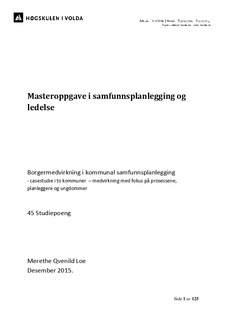| dc.contributor.advisor | Amdam, Jørgen | |
| dc.contributor.author | Loe, Merethe Qvenild | |
| dc.coverage.spatial | Herøy, Ulstein municipalities. Ytre Søre Synnmøre region, Norway | en |
| dc.date.accessioned | 2020-03-04T11:56:14Z | |
| dc.date.available | 2020-03-04T11:56:14Z | |
| dc.date.issued | 2015 | |
| dc.identifier.uri | http://hdl.handle.net/11250/2645200 | |
| dc.description.abstract | Sammendrag
Denne oppgaven er en studie av to case, i Ulstein kommune og i Herøy kommune i Møre og Romsdal. Studien omhandler medvirkning i samfunnsdelen av kommuneplanprosesser i de to kommunene. De siste årene har det i vårt samfunn vært økt fokus og satsing på medvirkning.
Kommuneplanen sin samfunnsdel er en overordnet plan, som gir grunnlaget for utvikling av detaljplanprosesser. Den har en strategisk rolle med visjoner og strategier for hele kommunesamfunnet inkludert kommuneadministrasjonen.
Studien har fokus på læring, det sees på planprosessen i sin helhet spesielt med henblikk på borgermedvirkning og hvordan borgermedvirkningen blitt gjennomført. Kommunenes organisering av planleggingen og planleggerrollen er tema sammen med hvordan og i hvilken grad ungdommer har medvirket.
Det er i oppgaven valgt en forholdsvis smal teoretisk tilnærming, oppgaven er teoritestende hvor medvirkningsstigen fra Sheryl Arnstein (1969) som blir bærebjelken i teoriutvalget, men annen planleggingsteori er også viktig.
I denne studien konkluderes det med at Herøy kommune og Ulstein kommunene har lagt opp til bred deltakelse fra grupper, foreninger og individer, og at kommunenes opplegg er både tilpasset og til dels lite tilpasset borgerne. Planleggere, politikere og medvirkende er enige i at medvirkning er viktig og at det styrker planens legitimitet og dermed gir det utslag på gjennomføring av planen.
Lovgiver gir lite konkrete føring er for hva som er adekvat medvirkning i kommunenes planprosesser, men oppmuntrer og lovfester medvirkning. Gjennom ny plan- og bygningslov er krav til medvirkning blitt styrket.
Planleggerrollen er kompleks, for å lykkes er det flere kriterier som må være oppfylt i forhold til ulike typer kompetanse, tidsmessige ressurser, politisk struktur og annet. Planomfanget er også komplekst både for politikere, ungdommer og andre medvirkende, tilpasset informasjon og medvirkningsopplegg er derfor helt nødvendig. | nb_NO |
| dc.description.abstract | Summary
The study deals with citizen participation in planning processes in municipals. This thesis is a study of the process of the strategic part of the municipal planning in two municipals. The cases are sourced in Ulstein kommune and Herøy kommune in Møre og Romsdal. In the current society there has been an increased focus and commitment to conduct citizen participation in general and in municipal planning.
This strategic plan is a determinative plan in the municipals, which provides the basis for development of detailed plans and planning processes. It has a strategic role with visions and strategies for the entire municipality including the municipal administration
I am studying the entire planning process in this thesis, but with a particular regard to citizen participation and how citizen participation has been conducted. The study has focus on the planners and the planning role as well as studying young people's participation.
I have a relatively narrow theoretical approach in this theses, the thesis is a theory-testing study. Sheryl Arnsteins (1969) article: “A ladder of citizen participation” has an important position in the study, but other planning theory is also important.
This study concludes that in Herøy municipality and in Ulstein municipality there has been a relatively comprehensive participation from groups, associations and individuals. Some of the arenas for citizen participation are customized and adequate for the ones that participate. Other arenas are poorly adapted to the citizens that participate. Planners, politicians and contributors agree that citizen participation is important and it is complicit the plan's legitimacy, and thus gives impact on implementation of the plan.
There are no specific guidelines from the legislator on how to conduct adequate participation in the planning processes in the municipals, but they encourage and statutory citizen participation. Requirement for participation has been increased in the new law of Planning and Building in Norway, compared to the previous law.
The planning role is complex, and in order to succeed, there are several criteria that must be met in relation to different types of expertise, time resources, political structure, and more. There are many different plans in our legislation, and it can be difficult for politicians, youngsters and other participants to get an overview of these. Customized information and arrangements for citizen participation are therefore essential | en |
| dc.language.iso | nob | |
| dc.publisher | Høgskulen i Volda | nn_NO |
| dc.subject | Herøy kommune | nb_NO |
| dc.subject | Ulstein kommune | nb_NO |
| dc.title | Borgermedvirkning i kommunal samfunnsplanlegging. Casestudie i to kommuner – medvirkning med fokus på prosessene, planleggere og ungdommer | nb_NO |
| dc.type | Master thesis | en |
| dc.rights.holder | forfattaren | nn_NO |
| dc.subject.nsi | VDP::Samfunnsvitenskap: 200::Urbanisme og fysisk planlegging: 230::Planleggingshistorie, -teori og -metodikk: 231 | nb_NO |
| dc.subject.nsi | VDP::Samfunnsvitenskap: 200::Statsvitenskap og organisasjonsteori: 240::Sammenlignende politikk: 241 | nb_NO |
| dc.source.pagenumber | 125 | nb_NO |
